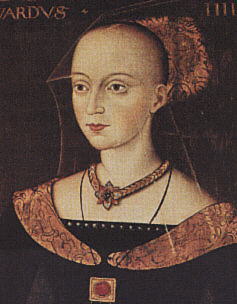The Fifteenth Century
THE GREY FAMILY DURING THE 'WAR OF THE ROSES':
The Grey family is descended from the Ferrers de Grey of Groby, and the Woodvilles. Elizabeth Woodville was one of the beauties of England in the 1400's. She was married to the much older John de Grey, 7th Baron Ferrers of Groby. They had two sons, including Thomas, when her husband died in the second Battle of St. Albans (1461).
That battle was one of the many in the War (of the Roses) between the fragile Lancastrian king HenryVI and his Yorkist cousins. Henry's loyal subjects lost the battle in 1461, and Henry went to prison. His most loyal subject, the 12th Earl of Oxford, John de Vere and his eldest son (of five) were executed.
Having won the second Battle of St. Alban's, the Yorkist faction crowned young Edward IV as the new king.
As a widow, Elizabeth was given to taking her children on walks in the countryside, and it was while hunting nearby that the very young King Edward IV met her walking with her children. He was so taken with her that he fell in love. He wooed her madly. The older men at court who ran England dissapproved strongly of any queen who was not of the correct family, and they dismissed Elizabeth as unsuitable for the king to marry. Edward would not be thwarted, and he arranged to get married secretly, without anyone knowing for months afterwards. When it finally all came out, his Earls were furious, for they had all been plotting to marry one of their own daughters to the king.
Elizabeth Woodville: circa 1465
Nevertheless, the king and his queen were happy together. In addition to her older sons, Thomas and Richard Grey, Elizabeth had two more sons by king Edward, and many daughters.
Unexpectedly, in his prime of life, the king fell victim to a mortal illness, and died.
The late king's brother, Richard, was appointed Lord Protector of the realm. But, instead of crowning the young Prince of Wales, he threw both of the dead king's boys into prison in the Tower of London. Then, he crowned himself king, Richard III. As his final act of treachery, he had the boys murdered and buried secretly beneath a masonry staircase in the Tower.
The dead boys' elder half brothers, Elizabeth's grown up sons Thomas and Richard Grey, joined a rebellion against the new king. However, Richard Grey was captured and beheaded without trial. Thomas escaped to France, to join the rebels under Henry Ap Tudor.
.....
The name 'Cecil' is first heard of in the 'Annales Cambraie', as in the entry for 1022 A.D., referring to Llewelin, son of Seisill, king of the Venedotiae.
Four hundred years later, the Cecil family name was, in Wales, spelt 'Sysill', when squire David Sysill signed on to support the campaign of the Earl of Richmond, Henry Ap Tudor, to sieze the kingdom of the English from Richard III. Richmond's shadow court had already been in open rebellion for seven desperate years, including their period of exile in France.
In the final contest, as Richard III and his army approached Bosworth field from the east, David Sysill was arriving from the west with the army of Henry Ap Tudor.
Thomas Grey was not in England that day. Since fleeing England, with a warrant for his arrest hanging over his head, and joining forces with Henry's court in exile, he had trained with the rebel army and taken his place at their side, but had been left in France due to an earlier failed attempt on his part to return secretly to England to meet with his mother.
Nevertheless, this day Tom would see his family avenged, and his title and lands restored to him, for, at Bosworth field, as the two armies hacked away at each other, Richard III broke free of the protection of his private guards to personally attack Henry Ap Tudor. Henry's men slew Richard III. Henry, the victor, at once received the homage and fealty of all combatants, and the entire host returned to London town to see Henry crowned king.
Tom Grey and David Sysill were both rewarded by the king for services rendered. David became Yeoman of Arms to the new king Henry VII.
.....

TIMELINE